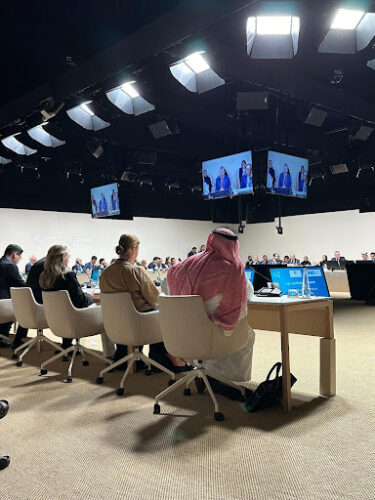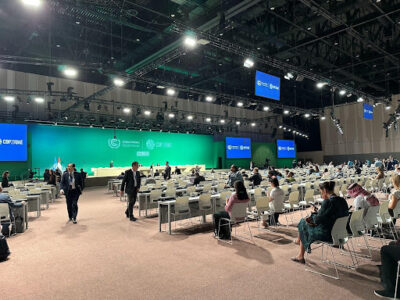The New Climate Policy
Industrial strategy, energy regulation, and America’s path forward from COP28
When many of us think about policy responses to climate change, we think of a vocabulary that dates back to the Clinton and Bush administrations—” carbon taxes,” “emissions limits,” and “cap-and-trade.” We understand these potential solutions as creatures of federal environmental law. And for those of us concerned about a warming world, Washington’s repeated failures to enact these policies (and the Supreme Court’s rejections of others) contribute to a deepening gloom that “we haven’t done anything” to avert catastrophe.

That story looks in the wrong places. The Inflation Reduction Act, passed in 2022, is our country’s once-in-a-generation climate policy. That sweeping piece of legislation offers generous tax credits for renewable energy, batteries, hydrogen, electric vehicles, and more. It has mobilized hundreds of billions of dollars, accomplishing via industrial policy much of what America has failed to do via regulation (and, in unexpected ways, more than environmental regulators even contemplated). Separate from the Act, decades of scientific innovation have made renewables and energy storage cost-competitive even before accounting for tax credits.
Beyond Congress, U.S. policymakers are doing more than just subsidizing renewables. Once-sleepy corners of state governments tasked with regulating electric and natural gas utilities, called “public utility commissions” in many states, are implementing policies to combat climate change while keeping energy rates low. These agencies, for example, administer thirty states’ portfolio requirements to expand clean electricity generation. Meanwhile, the commissions’ federal counterpart, the Federal Energy Regulatory Commission (FERC), is facilitating the interstate grid expansion necessary to transition our energy mix and improve resiliency against worsening extreme weather.

I started to unravel the mysteries of these regulatory agencies in an energy law course during my first year at Stanford and have been captivated ever since. While clerking at California’s Public Utility Commission in summer 2022, I worked on topics as diverse as electric vehicle charging, nuclear reactor retirements, and natural gas safety. Now, during my final year at Stanford, I support FERC Commissioner Allison Clements as the federal Commission tackles foundational (if obscure-sounding) climate challenges like interconnection queue reform and transmission planning. FERC’s interconnection rule, for example, will speed up approvals for more than ten-thousand projects—over ninety-percent of which are zero-carbon—that are currently waiting to be plugged into the nation’s electric grid. And FERC’s forthcoming planning rule would replace reactive grid planning with a long-term, forward-looking approach.

These developments have placed climate policy more and more within the ambit of energy regulation and industrial policy than environmental law. That is a good thing. Environmental regulation has done immense good in its history, but the one hammer it wields very effectively—stopping polluters—can solve only part of the climate challenge. Our only plausible path to abate global warming is to replace trillions of dollars of fossil fuel infrastructure with a buildout of clean energy infrastructure at a similar magnitude. That process requires clarity and urgency, not obstruction and delay. It is by building a cleaner future that America will combat environmental injustices, support continuing prosperity in transitioning fossil fuel communities, and reduce the impacts of climate change on the most imperiled.
As I round the corner towards graduation, I am grateful for the opportunities Stanford gave me to develop my own sense of clarity and urgency. At the Law School, I studied under leading experts on energy, administrative, and environmental law. I spent a quarter exploring litigation-driven climate approaches as a student attorney with the Environmental Law Clinic. And at the Doerr School of Sustainability, I discovered the intricate legal and financial mechanics of renewable energy project development. I have been endlessly inspired by my classmates from across the University who have built deep expertise in far-flung corners of the energy transition.

After a Stanford experience focused squarely on the technocratic particulars of climate policy, an unexpected capstone found me in Dubai. I traveled there to represent Stanford at COP28, the United Nations’ annual climate conference. The context of this year’s COP shaded my visit, from the host country’s history of human rights abuses (including construction of the conference facility itself), to rampant oil lobbying, to the admitted strangeness of flying halfway around the world for a climate conference. On the ground in Dubai, it was difficult to connect the detail-oriented work I do at Stanford to the soaring rhetoric I encountered on the global stage.
And yet when I walked into the plenary room, where representatives from every nation on earth gather to help chart a better path, I couldn’t help but be moved. Nothing about the climate transition is preordained, but whatever progress we make will require some dose of the particular and some of the universal. Back at home, my wife Megan and I are expecting our first child this spring. I look forward to telling him, in a few years, that we’re doing the best we can.
Ian Faucher is a 3L pursuing a joint degree at Stanford Law School and the Stanford Doerr School of Sustainability. He will join Orrick, Herrington & Sutcliffe’s renewable energy team in San Francisco after graduation. He represented Stanford University at the U.N.’s COP 28 Climate Conference in Dubai in December, 2023.
